Assessment of Compressive Mechanical Behavior of Bis-GMA Polymer Using Hyperelastic Models
Abstract
1. Introduction
2. Hyperelastic Constitutive Model
3. Material and Experiment Method
3.1. Sample Preparation
3.2. Compression Test Method
3.3. Nano-Indentation Test Method
4. Finite Element Simulation
5. Hybrid Experimental-Computational Approach
6. Results and Discussion
6.1. Compression Test Results
6.2. Examination of Bis-GMA Polymer Hyperelastic Behavior Through Nano-Indentation Test
6.3. FE Simulation Results
6.3.1. Initial Selection of the Proper Hyperelastic Models
6.3.2. Prediction of the Bis-GMA Polymer Structural Response
6.3.3. Prediction of the Bis-GMA Polymer Structural Deformation
6.3.4. Identification of the Best Hyperelastic Model
6.4. Determination of the Bis-GMA Polymer True Stress–Strain Curve
7. Conclusion
Author Contributions
Funding
Acknowledgments
Conflicts of Interest
References
- Koloor, S.S.R.; Khosravani, M.R.; Hamzah, R.I.R.; Tamin, M.N. FE model-based construction and progressive damage processes of FRP composite laminates with different manufacturing processes. Int. J. Mech. Sci. 2018, 141, 223–235. [Google Scholar] [CrossRef]
- Douba, A.; Emiroglu, M.; Kandil, U.F.; Reda Taha, M.M. Very ductile polymer concrete using carbon nanotubes. Constr. Build. Mater. 2019, 196, 468–477. [Google Scholar] [CrossRef]
- Arakawa, K.; Mada, T.; Todo, M.; Takahashi, J.; Ooka, S. Impact tensile fracture testing of a brittle polymer. Polym. Test. 2006, 25, 1095–1100. [Google Scholar] [CrossRef]
- Rahimi, A.S.; Ayatollahi, M.R.; Torabi, A.R. Ductile failure analysis of blunt V-notched epoxy resin plates subjected to combined tension-shear loading. Polym. Test. 2018, 70, 57–66. [Google Scholar] [CrossRef]
- Yang, L.M.; Shim, V.P.W.; Lim, C.T. A visco-hyperelastic approach to modelling the constitutive behaviour of rubber. Int. J. Impact Eng. 2000, 24, 545–560. [Google Scholar] [CrossRef]
- Khalajmasoumi, M.; Koloor, S.S.R.; Arefnia, A.; Ibrahim, I.S.; Yatim, J.M. Hyperelastic Analysis of High Density Polyethylene under Monotonic Compressive Load. Appl. Mech. Mater. 2012, 229–231, 309–313. [Google Scholar] [CrossRef]
- Muhr, A.H. Modeling the Stress–strain Behavior of Rubber. Rubber Chem. Technol. 2005, 78, 391–425. [Google Scholar] [CrossRef]
- Elhaouzi, F.; Nourdine, A.; Brosseau, C.; Mdarhri, A.; El Aboudi, I.; Zaghrioui, M. Hyperelastic Behavior and Dynamic Mechanical Relaxation in Carbon Black-Polymer Composites. Polym. Compos. 2018. [Google Scholar] [CrossRef]
- Shin, H.; Choi, J.; Cho, M. An efficient multiscale homogenization modeling approach to describe hyperelastic behavior of polymer nanocomposites. Compos. Sci. Technol. 2019, 175, 128–134. [Google Scholar] [CrossRef]
- Ju, M.L.; Mezghani, S.; Jmal, H.; Dupuis, R.; Aubry, E. Parameter estimation of a hyperelastic constitutive model for the description of polyurethane foam in large deformation. Cell. Polym. 2013, 32, 21–40. [Google Scholar] [CrossRef]
- Chen, Z.; Diebels, S. Modelling and parameter re-identification of nanoindentation of soft polymers taking into account effects of surface roughness. Comput. Math. Appl. 2012, 64, 2775–2786. [Google Scholar] [CrossRef]
- Luczynski, K.W.; Dejaco, A.; Lahayne, O.; Jaroszewicz, J.; Swieszkowski, W.; Hellmich, C. MicroCT/Micromechanics-Based Finite Element Models and Quasi-Static Unloading Tests Deliver Consistent Values for Young’s Modulus of Rapid-Prototyped Polymer-Ceramic Tissue Engineering Scaffold. Comput. Model. Eng. Sci. 2012, 87, 505–528. [Google Scholar]
- Mathews, M.; Wang, H.-T.; Li, L. Finite Element Analysis of Nanoindentation and Elastic Behavior of Bi2Te3 Two-Dimensional Nanosheets. ECS J. Solid State Sci. Technol. 2016, 5, Q3082–Q3087. [Google Scholar] [CrossRef]
- Lin, D.C.; Shreiber, D.I.; Dimitriadis, E.K.; Horkay, F. Spherical indentation of soft matter beyond the Hertzian regime: Numerical and experimental validation of hyperelastic models. Biomech. Model. Mechanobiol. 2009, 8, 345–358. [Google Scholar] [CrossRef] [PubMed]
- Ehret, A.E.; Itskov, M. A polyconvex hyperelastic model for fiber-reinforced materials in application to soft tissues. J. Mater. Sci. 2007, 42, 8853–8863. [Google Scholar] [CrossRef]
- Zhang, P.; To, A.C. Transversely isotropic hyperelastic-viscoplastic model for glassy polymers with application to additive manufactured photopolymers. Int. J. Plast. 2016, 80, 56–74. [Google Scholar] [CrossRef]
- Bois, P.A.D.; Kolling, S.; Koesters, M.; Frank, T. Material behaviour of polymers under impact loading. Int. J. Impact Eng. 2006, 32, 725–740. [Google Scholar] [CrossRef]
- Ayoub, G.; Zaïri, F.; Fréderix, C.; Gloaguen, J.M.; Naït-Abdelaziz, M.; Seguela, R.; Lefebvre, J.M. Effects of crystal content on the mechanical behaviour of polyethylene under finite strains: Experiments and constitutive modelling. Int. J. Plast. 2011, 27, 492–511. [Google Scholar] [CrossRef]
- Ottosen, N.S.; Ristinmaa, M. Hyperelasticity. In The Mechanics of Constitutive Modeling; Ottosen, N.S., Ristinmaa, M., Eds.; Elsevier Science Ltd.: Oxford, UK, 2005; pp. 67–102. [Google Scholar] [CrossRef]
- Shannahan, L.S. A Hybrid Experimental-Computational Approach for the Analysis of Dynamic Fracture. Ph.D. Thesis, Drexel University, Ann Arbor, MI, USA, 2017. [Google Scholar]
- Perahia, D.; Grest, G.S. From Interfaces to Bulk: Experimental-Computational Studies Across Time and Length Scales of Multi-Functional Ionic Polymers; DOE-Clemson-001; Clemson Univ.: Clemson, SC, USA, 2017. [Google Scholar] [CrossRef]
- Meredig, B.; Wolverton, C. A hybrid computational–experimental approach for automated crystal structure solution. Nat. Mater. 2013, 12, 123–127. [Google Scholar] [CrossRef] [PubMed]
- Tamin, M.N.; Nor, F.M.; Wei Keat, L. Hybrid Experimental-Computational Approach for Solder/IMC Interface Shear Strength Determination in Solder Joints. IEEE Trans. Compon. Packag. Technol. 2010, 33, 614–620. [Google Scholar] [CrossRef]
- Khalajmasoumi, M.; Koloor, S.S.R.; Arefnia, A.; Ibrahim, I.S.; Yatim, J.M. Finite element analysis of curvature precast polymer panel for temporary support of tunnels. Appl. Mech. Mater. 2012, 229–231, 771–777. [Google Scholar] [CrossRef]
- Praharaj, A.P.; Behera, D.; Bastia, T.K. Fabrication and Mechanical Properties of BisGMA/Amine Functionalized Paper Pulp Composites. Int. J. Innov. Res. Sci. Eng. Technol. 2014, 3, 12719–12723. [Google Scholar]
- MacDonald, K.; Boyd, D. Mechanical loading, an important factor in the evaluation of ion release from bone augmentation materials. Sci. Rep. 2018, 8, 14225. [Google Scholar] [CrossRef] [PubMed]
- Kawanabe, K.; Tamura, J.; Yamamuro, T.; Nakamura, T.; Kokubo, T.; Yoshihara, S. A new bioactive bone cement consisting of BIS-GMA resin and bioactive glass powder. J. Appl. Biomater. 1993, 4, 135–141. [Google Scholar] [CrossRef]
- Sideridou, I.; Tserki, V.; Papanastasiou, G. Effect of chemical structure on degree of conversion in light-cured dimethacrylate-based dental resins. Biomaterials 2002, 23, 1819–1829. [Google Scholar] [CrossRef]
- Linden, L. Dental polymers. In Polymeric Materials Encyclopedia; Salamone, C., Ed.; CRC Press: New York, NY, USA, 1996; Volume 3D–E, p. 1839. [Google Scholar]
- Hosseinzadeh-Nik, T.; Karimzadeh, A.; Ayatollahi, M.R. Bond strength of a nano-composite used for bonding ceramic orthodontic brackets. Mater. Des. 2013, 51, 902–906. [Google Scholar] [CrossRef]
- Karimzadeh, A.; Ayatollahi, M.R.; Hosseinzadeh-Nik, T. Effects of a Nano-composite Adhesive on Mechanical Properties of Tooth Enamel After Removing Orthodontics Bracket—An Experimental Study Using Nano-indentation Test. Exp. Mech. 2015, 55, 1769–1777. [Google Scholar] [CrossRef]
- Karimzadeh, A.; Ayatollahi, M.R.; Bushroa, A.R. Effect of dental restorative material type and shade on characteristics of two-layer dental composite systems. Lat. Am. J. Solids Struct. 2016, 13, 1851–1865. [Google Scholar] [CrossRef]
- Karimzadeh, A.; Ayatollahi, M.R.; Hosseinzadeh Nik, T. Tribological Properties of Dental Enamel Before and After Orthodontic Bracket Bonding-Debonding by Nano-Scratch Test. J. Mech. 2019, 35, 279–287. [Google Scholar] [CrossRef]
- Karimzadeh, A.; Ayatollahi, M.R.; Nikkhooyifar, M.; Bushroa, A.R. Nanomechanical properties and wear resistance of dental restorative materials. Struct. Eng. Mech. 2017, 64, 819–826. [Google Scholar] [CrossRef]
- Kalachandra, S.; Taylor, D.; DePorter, C.; McGrath, J. Polymeric materials for composite matrices in biological environments. Polymer 1993, 34, 778–782. [Google Scholar] [CrossRef]
- Gajewski, V.; Pfeifer, C.; Fróes-Salgado, N.; Boaro, L.; Braga, R. Monomers Used in Resin Composites: Degree of Conversion, Mechanical Properties and Water Sorption/Solubility. Braz. Dent. J. 2012, 23, 508–514. [Google Scholar] [CrossRef]
- Tiwari, A.; Polykarpov, A. Photocured Materials, Volume 13 of Rsc Smart Materials, Chapter 15: Methacrylate and Epoxy Resins Photocured by Means of Visible Light-Emitting Diodes (LEDs); Royal Society of Chemistry: London, UK, 2014; p. 370. [Google Scholar]
- Barszczewska-Rybarek, I.M. Structure–property relationships in dimethacrylate networks based on Bis-GMA, UDMA and TEGDMA. Dent. Mater. 2009, 25, 1082–1089. [Google Scholar] [CrossRef]
- Floyd, C.J.E.; Dickens, S.H. Network structure of Bis-GMA- and UDMA-based resin systems. Dent. Mater. 2006, 22, 1143–1149. [Google Scholar] [CrossRef]
- Barszczewska-Rybarek, I.; Chladek, G. Studies on the Curing Efficiency and Mechanical Properties of Bis-GMA and TEGDMA Nanocomposites Containing Silver Nanoparticles. Int. J. Mol. Sci. 2018, 19, 3937. [Google Scholar] [CrossRef]
- Emami, N.; Soderholm, K. Young’s modulus and degree of conversion of different combination of light-cure dental resins. Open Dent. J. 2009, 3, 202–207. [Google Scholar] [CrossRef][Green Version]
- Naumann, M.; Sterzenbach, G.; Pröschel, P. Evaluation of load testing of postendodontic restorations in vitro: Linear compressive loading, gradual cycling loading and chewing simulation. J. Biomed. Mater. Res. Part. B Appl. Biomater. 2005, 74B, 829–834. [Google Scholar] [CrossRef]
- Drummond, J.L. Degradation, Fatigue, and Failure of Resin Dental Composite Materials. J. Dent. Res. 2008, 87, 710–719. [Google Scholar] [CrossRef]
- Ferracane, J.L.; Greener, E.H. The effect of resin formulation on the degree of conversion and mechanical properties of dental restorative resins. J. Biomed. Mater. Res. 1986, 20, 121–131. [Google Scholar] [CrossRef]
- Magne, P.; Versluis, A.; Douglas, W.H. Effect of luting composite shrinkage and thermal loads on the stress distribution in porcelain laminate veneers. J. Prosthet. Dent. 1999, 81, 335–344. [Google Scholar] [CrossRef]
- Ogden, R.W. Non-Linear Elastic Deformations; Dover Publications: New York, NY, USA, 2013. [Google Scholar]
- Arruda, E.M.; Boyce, M.C. A three-dimensional constitutive model for the large stretch behavior of rubber elastic materials. J. Mech. Phys. Solids 1993, 41, 389–412. [Google Scholar] [CrossRef]
- Bower, A.F. Applied Mechanics of Solids, Chapter 3: Constitutive Equations: Relations between Stress and Strain; CRC Press: Boca Raton, FL, USA, 2009. [Google Scholar]
- Section 22.5.1 of the Abaqus Analysis User’s Guide: Hyperelastic Behavior of Rubberlike Materials; Abaqus 6.14 Online Documentation; Dassault Systèmes: Providence, RI, USA, 2014.
- Ogden, R.W. Large Deformation Isotropic Elasticity—On the Correlation of Theory and Experiment for Incompressible Rubberlike Solids. Proc. R. Soc. Lond. A Math. Phys. Sci. 1972, 326, 565–584. [Google Scholar] [CrossRef]
- Yeoh, O.H. Characterization of Elastic Properties of Carbon-Black-Filled Rubber Vulcanizates. Rubber Chem. Technol. 1990, 63, 792–805. [Google Scholar] [CrossRef]
- Kilian, H.G.; Enderle, H.F.; Unseld, K. The use of the van der Waals model to elucidate universal aspects of structure-property relationships in simply extended dry and swollen rubbers. Colloid Polym. Sci. 1986, 264, 866–876. [Google Scholar] [CrossRef]
- Kossa, A.; Berezvai, S. Novel strategy for the hyperelastic parameter fitting procedure of polymer foam materials. Polym. Test. 2016, 53, 149–155. [Google Scholar] [CrossRef]
- Shahzad, M.; Kamran, A.; Siddiqui, M.Z.; Farhan, M. Mechanical Characterization and FE Modelling of a Hyperelastic Material. Mater. Res. 2015, 18, 918–924. [Google Scholar] [CrossRef]
- Mishra, M.; Szlufarska, I. Possibility of high-pressure transformation during nanoindentation of SiC. Acta Mater. 2009, 57, 6156–6165. [Google Scholar] [CrossRef]
- Randolph, L.D.; Palin, W.M.; Bebelman, S.; Devaux, J.; Gallez, B.; Leloup, G.; Leprince, J.G. Ultra-fast light-curing resin composite with increased conversion and reduced monomer elution. Dent. Mater. 2014, 30, 594–604. [Google Scholar] [CrossRef]
- ASTM D695-15. Standard Test Method for Compressive Properties of Rigid Plastics; ASTM International: West Conshohocken, PA, USA, 2015. [Google Scholar]
- ISO-14577-1. Metallic Materials—Instrumented Indentation Test for Hardness and Materials Parameters; Part 1: Test. Method; International Organization for Standardization (ISO): Geneva, Switzerland, 2002. [Google Scholar]
- Karimzadeh, A.; Ayatollahi, M.R.; Alizadeh, M. Finite element simulation of nano-indentation experiment on aluminum 1100. Comput. Mater. Sci. 2014, 81, 595–600. [Google Scholar] [CrossRef]
- Greaves, G.N.; Greer, A.L.; Lakes, R.S.; Rouxel, T. Poisson’s ratio and modern materials. Nat. Mater. 2011, 10, 823–837. [Google Scholar] [CrossRef]
- Mott, P.H.; Roland, C.M. Limits to Poisson’s ratio in isotropic materials. Phys. Rev. B 2009, 80, 132104–132108. [Google Scholar] [CrossRef]
- Nitta, K.-H.; Yamana, M. Chapter 5: Poisson’s Ratio and Mechanical Nonlinearity Under Tensile Deformation in Crystalline Polymers. In Rheology; InTech: Rijeka, Croatia, 2012; pp. 113–130. [Google Scholar]
- Karimzadeharani, A. Investigation on Orthodontic Bond Strength Using Experimental and Numerical Methods; Iran University of Science and Technology: Tehran, Iran, 2017. [Google Scholar]
- Oliver, W.C.; Pharr, G.M. Measurement of hardness and elastic modulus by instrumented indentation: Advances in understanding and refinements to methodology. J. Mater. Res. 2004, 19, 3–20. [Google Scholar] [CrossRef]
- Ng, T.P.; Koloor, S.S.R.; Djuansjah, J.R.P.; Abdul Kadir, M.R. Assessment of compressive failure process of cortical bone materials using damage-based model. J. Mech. Behav. Biomed. Mater. 2017, 66, 11. [Google Scholar] [CrossRef]
- Hua, Y.; Gu, L.; Watanabe, H. Micromechanical analysis of nanoparticle-reinforced dental composites. Int. J. Eng. Sci. 2013, 69, 69–76. [Google Scholar] [CrossRef][Green Version]
- De Souza Venter, S.A.; Fávaro, S.L.; Radovanovic, E.; Girotto, E.M. Hardness and degree of conversion of dental restorative composites based on an organic-inorganic hybrid. Mat. Res. 2013, 16, 898–902. [Google Scholar] [CrossRef]
- Hochstetter, G.; Jimenez, A.; Cano, J.P.; Felder, E. An attempt to determine the true stress—Strain curves of amorphous polymers by nanoindentation. Tribol. Int. 2003, 36, 973–985. [Google Scholar] [CrossRef]
- Haward, R.N. The derivation of a strain hardening modulus from true stress–strain curves for thermoplastics. Polymer 1994, 35, 3858–3862. [Google Scholar] [CrossRef]
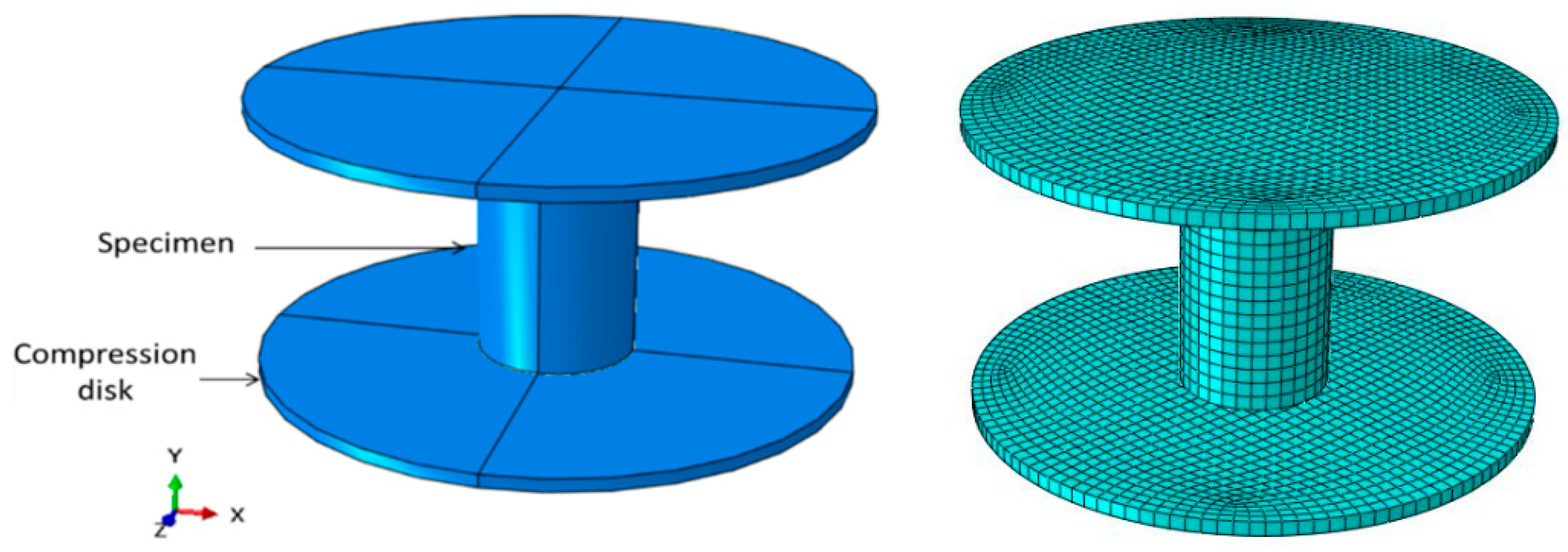
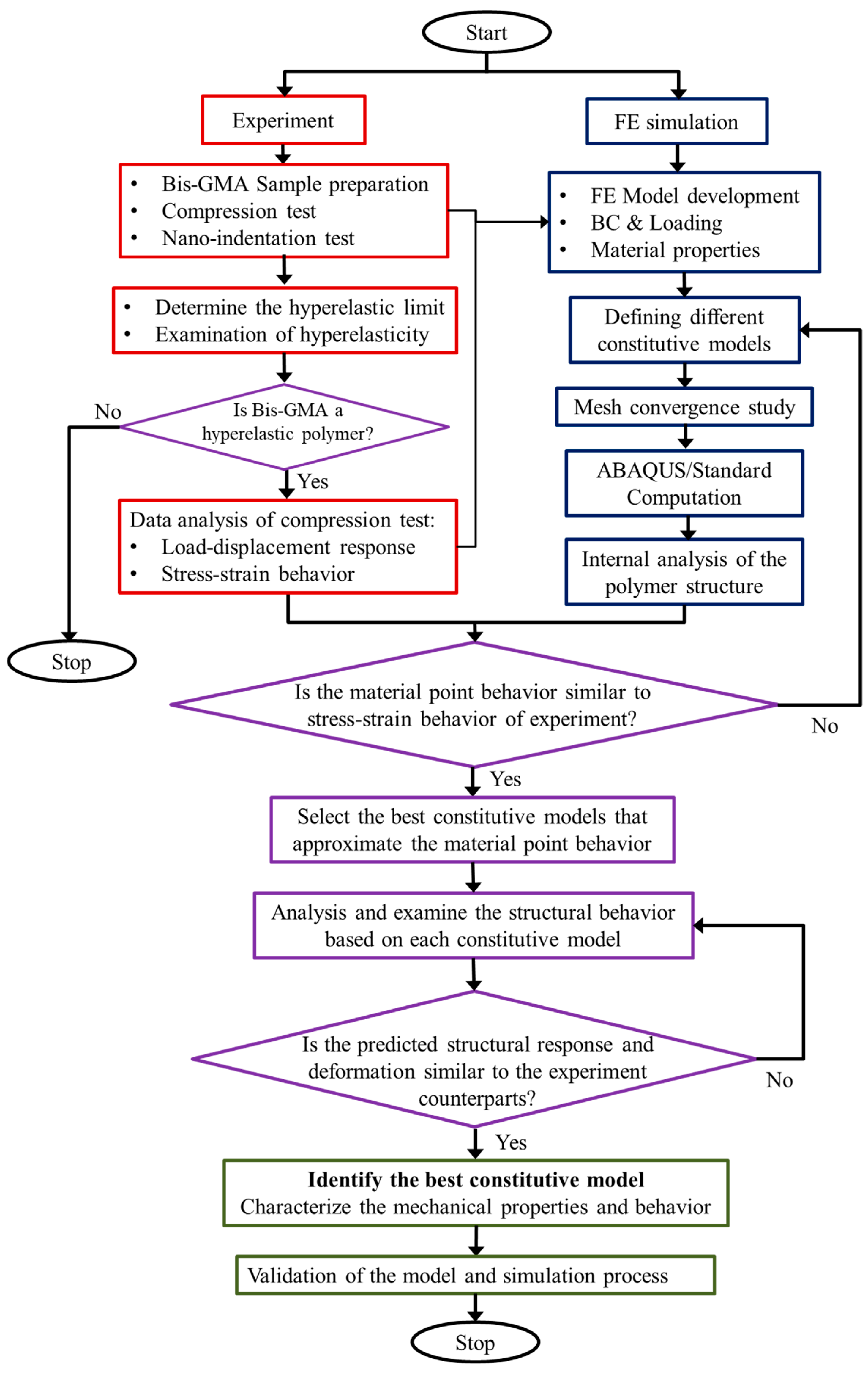
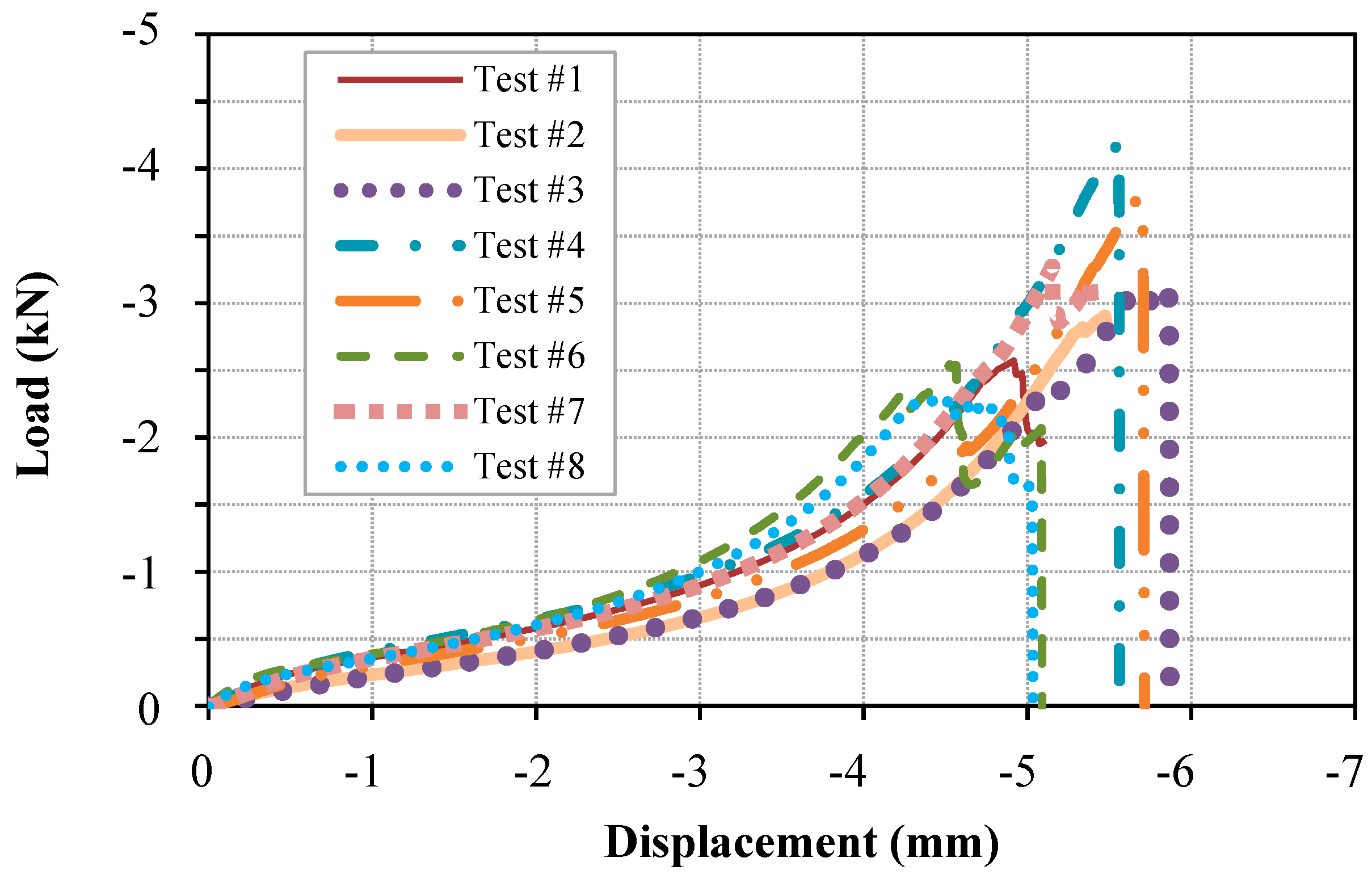


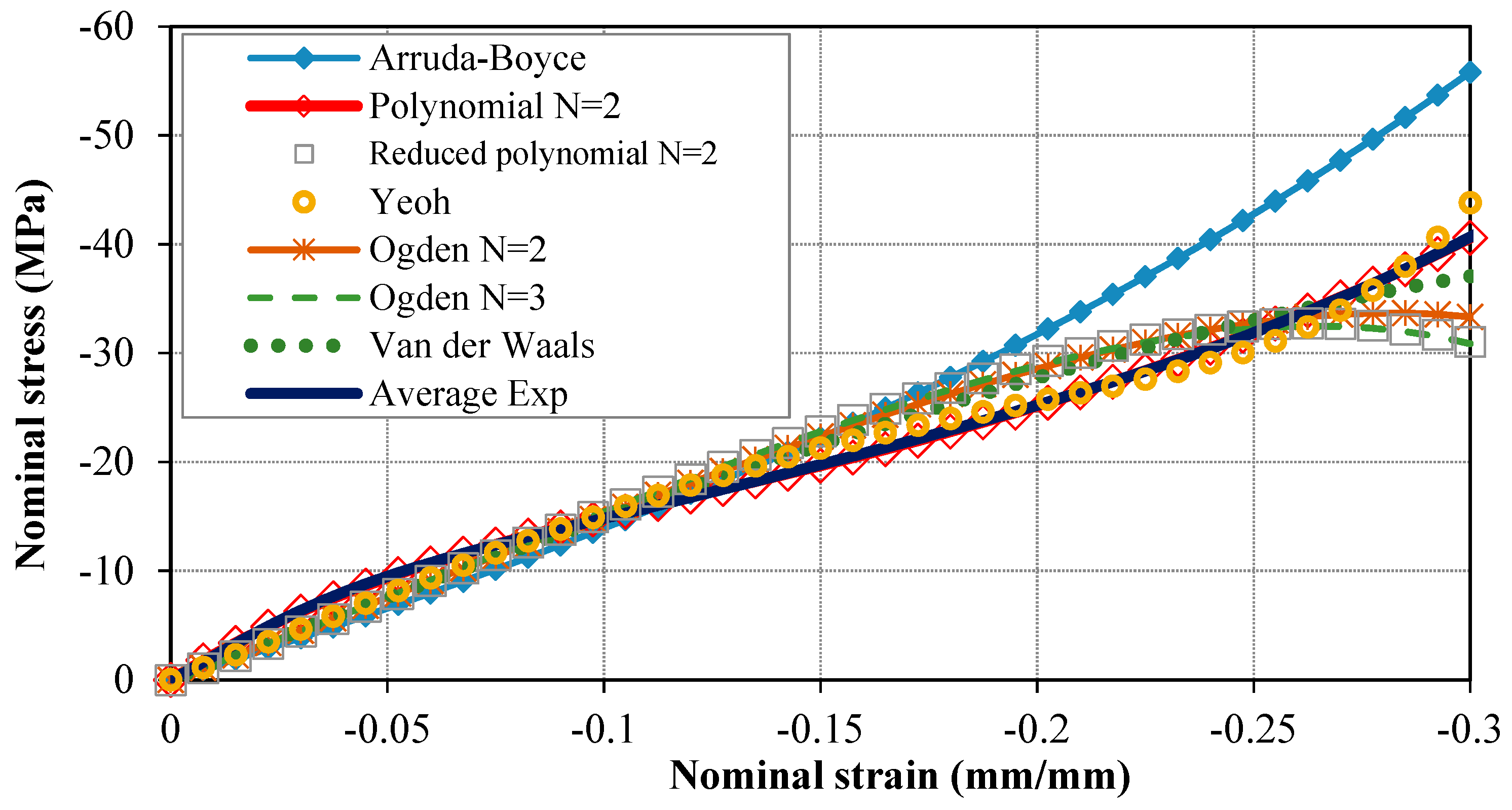
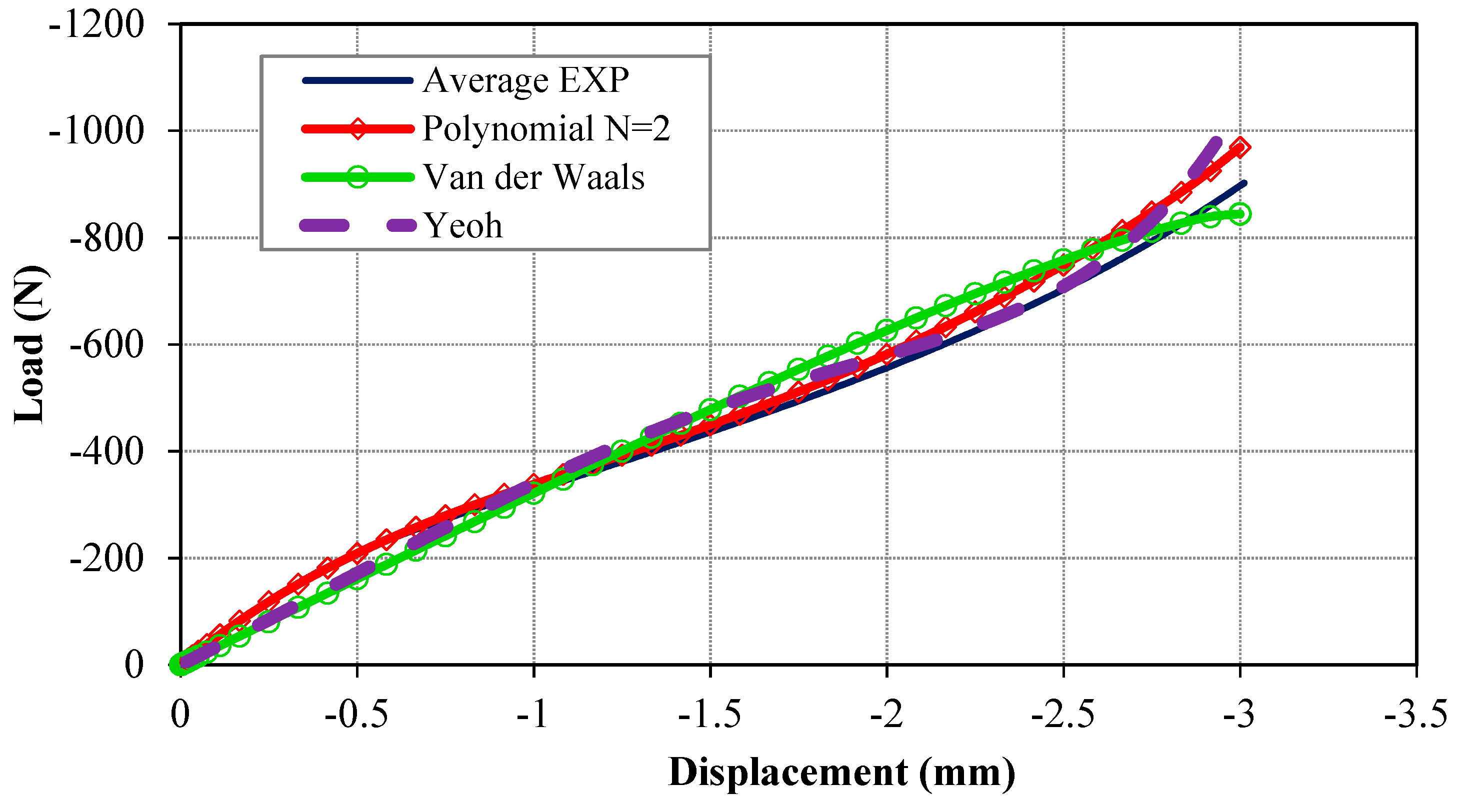

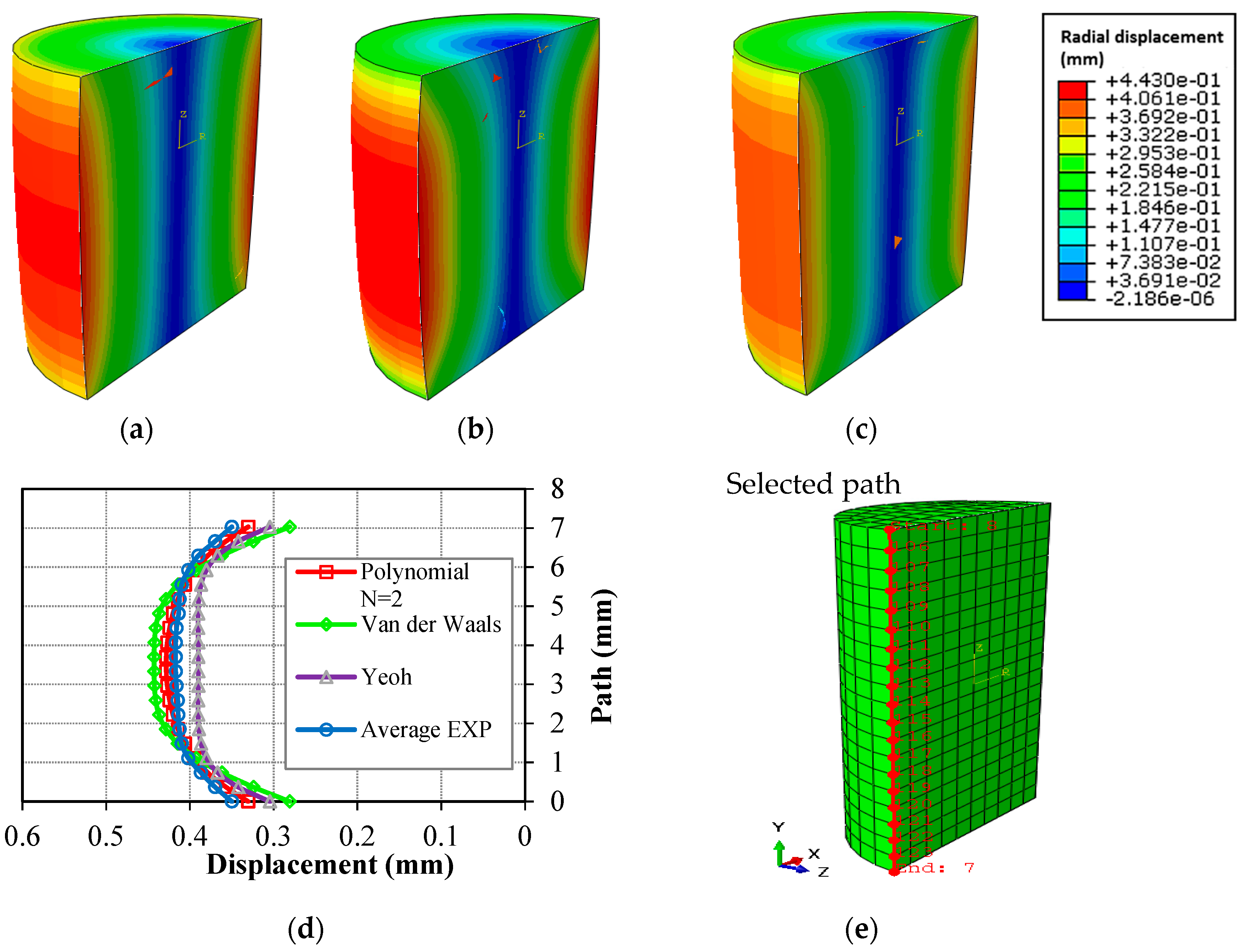
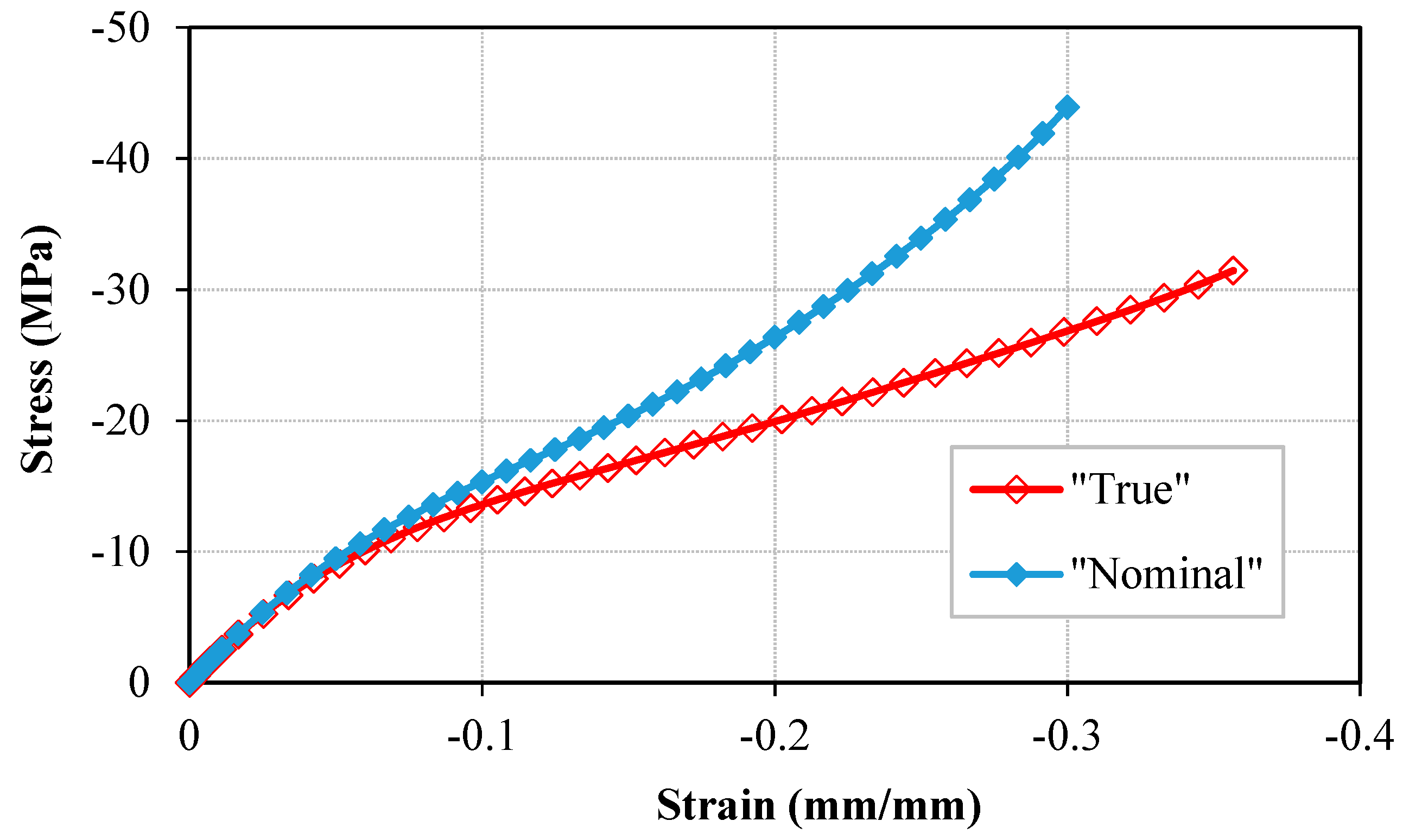
| Model Name | Equation | Detail |
|---|---|---|
| Arruda-Boyce form [47] | - | |
| Polynomial form [48] | N = 1, 2 | |
| Reduced polynomial form [49] | N = 1, 2, …, 6 | |
| Ogden form [50] | N = 1, 2, …, 6 | |
| Yeoh form [51] | Reduced polynomial N = 3 | |
| Van der Waals form [52] | - |
| Commercial Name | Chemical Name | Molecular Formula | Molecular Weight (g/mol) | Manufacturer |
|---|---|---|---|---|
| Bis-GMA | 2,2-bis[4-(2-hydroxy-3-methacryloxypropoxy)phenyl propane | C29H36O8 | 512.59 | Sigma-Aldrich Inc., St. Louis, MO, USA |
| Camphorquinone | 2,3-bornadenione | C10H14O2 | 166 | Sigma-Aldrich Inc., St. Louis, MO, USA |
| DMAEMA | 2-(dimethylamino) ethyl methacrylate | C7H14NO2 | 157 | Sigma-Aldrich Inc., St. Louis, MO, USA |
© 2019 by the authors. Licensee MDPI, Basel, Switzerland. This article is an open access article distributed under the terms and conditions of the Creative Commons Attribution (CC BY) license (http://creativecommons.org/licenses/by/4.0/).
Share and Cite
Karimzadeh, A.; Ayatollahi, M.R.; Rahimian Koloor, S.S.; Bushroa, A.R.; Yahya, M.Y.; Tamin, M.N. Assessment of Compressive Mechanical Behavior of Bis-GMA Polymer Using Hyperelastic Models. Polymers 2019, 11, 1571. https://doi.org/10.3390/polym11101571
Karimzadeh A, Ayatollahi MR, Rahimian Koloor SS, Bushroa AR, Yahya MY, Tamin MN. Assessment of Compressive Mechanical Behavior of Bis-GMA Polymer Using Hyperelastic Models. Polymers. 2019; 11(10):1571. https://doi.org/10.3390/polym11101571
Chicago/Turabian StyleKarimzadeh, Atefeh, Majid Reza Ayatollahi, Seyed Saeid Rahimian Koloor, Abd Razak Bushroa, Mohd Yazid Yahya, and Mohd Nasir Tamin. 2019. "Assessment of Compressive Mechanical Behavior of Bis-GMA Polymer Using Hyperelastic Models" Polymers 11, no. 10: 1571. https://doi.org/10.3390/polym11101571
APA StyleKarimzadeh, A., Ayatollahi, M. R., Rahimian Koloor, S. S., Bushroa, A. R., Yahya, M. Y., & Tamin, M. N. (2019). Assessment of Compressive Mechanical Behavior of Bis-GMA Polymer Using Hyperelastic Models. Polymers, 11(10), 1571. https://doi.org/10.3390/polym11101571









